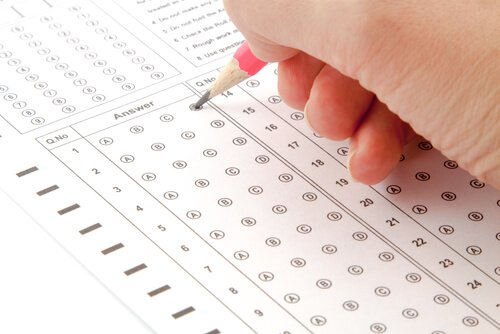Personality Evaluation

When we go to job interviews, the human resource experts commonly ask a series of questions that have a common goal: to evaluate our personality. Thanks to this, they can further determine whether or not we represent a suitable match for the job.
These types of interviews don’t just take place in the workplace, but also in other areas. For example, a clinician may do a personality evaluation to make a diagnosis and determine if someone suffers from a personality disorder. In the military or legal fields, a personality evaluation evaluates people involved in the judicial process.
In the same way, interviews represent just one of the many ways to evaluate one’s personality. Many more exist, such as questionnaires or objective tests.
Evaluator requirements
To carry out a rigorous personality assessment, you must have the appropriate theoretical training and experience. In addition, the theoretical models behind these evaluations support professional evaluations. Having knowledge of them is essential.
Regarding interpretation, evaluation tests give us a personality profile. However, no linear relationship between this profile and a specific behavior pattern exists. In other words, all people who score high in extraversion don’t act that way. In the same way, the same profile can suggest different personality types. Therefore, be cautious.

Personality evaluation questionnaires
Personality evaluation questionnaires pose a series of questions or affirmations that the subjects have to answer. Thus, their main personality and character traits are extracted through their answers. No correct or incorrect answers exist. The answers simply reflect on the candidate, how they behave, think, or face different situations.
The elements within a questionnaire don’t have to be ordered or graded. Instead, each item can be interpreted independently. Two types exist:
- General: to try to define a person’s characteristics outside the clinical setting. In other words, they’re designed for personality profiles. Numerous fields can apply the results.
- Clinical: aimed at determining pathological characteristics in a clinical setting. They’re designed to identify the factors that make someone be at levels higher or lower than what’s considered normal and, therefore, make them maladapted.
Objective tests
Objective tests are usually the tools most often used to assess personality, along with projective tests. They allow different aspects to be evaluated: knowledge, abilities, attitudes, intelligence, etc. They don’t usually have a time limit. They ask questions or explain different scenarios so that the person answers personally and sincerely. In these types of tests, no right or wrong answers exist.
Objective tests are widely used for diagnostic evaluations and are frequently applied in school settings. Two types exist:
- Inventories: these sheets contain numerous questions that measure personality variables. They show whether an individual agrees or disagrees with the statements. Professionals can administer them to a large number of people. Some of the most representative ones include the MMPI, the 16PF, and the NEO-PI-R.
- Other tests, such as personality indicators, tend to be complementary to inventories. They are, for example, measures of expressive behavior (how one walks, speaks, writes…), physiological variables (heart rate, reaction times…) or performance tests (problem-solving, definitions…)

Using these tests avoids a tendency response (like always answering “B”) or social desirability (answering in a socially acceptable way).
Projective tests
These types of tests have to be supervised by the therapist because they require a lot of training and learning. Normally, they help the evaluator understand how the interviewee sees, focuses on, and manages reality. As the name suggests, these tests allow the person to project their personality traits. Therefore, they determine what is within each person.
These are open, unstructured, and very reliable personality evaluations. They consist of providing few and brief instructions to the person. Thus, almost without being aware of it, the tests show their characteristics. The person’s answers are manifestations of their internal personality dynamics.
Types of subjective tests
- Complete the sentence: The person must finish the presented sentences. In this way, they provide information about their temperament in a specific situation.
- Describing ink blots: The most well-known ink blot tests include those developed by Hermann Rorschach. There are 10 sheets: 5 in black ink and 5 in color. The professional makes an interpretation based on the idea that the way the subject perceives the ink blot will reflect their personality.

- Drawing pictures: the evaluator asks the person to draw something. The drawing’s formal characteristics help determine the individual’s personality. These may include the inclination of the paper, the intensity of the stroke, or the size, structure, color, or position. The most well-known test is the Buck format (with a tree, person, and house). Professionals usually use Elizabeth Koppitz’s human figure test with children.
- Elaborating stories: this consists of writing or narrating a story. Professionals frequently use the TAT (Thematic Apperception Test) designed by Murray, in which a person must tell a story in 31 sheets.
As we can see, there are multiple ways to evaluate personality and all of its different factors, traits, and variables. Professionals have to know the most appropriate technique to use in each case and to take into account each subject’s individual differences.
When we go to job interviews, the human resource experts commonly ask a series of questions that have a common goal: to evaluate our personality. Thanks to this, they can further determine whether or not we represent a suitable match for the job.
These types of interviews don’t just take place in the workplace, but also in other areas. For example, a clinician may do a personality evaluation to make a diagnosis and determine if someone suffers from a personality disorder. In the military or legal fields, a personality evaluation evaluates people involved in the judicial process.
In the same way, interviews represent just one of the many ways to evaluate one’s personality. Many more exist, such as questionnaires or objective tests.
Evaluator requirements
To carry out a rigorous personality assessment, you must have the appropriate theoretical training and experience. In addition, the theoretical models behind these evaluations support professional evaluations. Having knowledge of them is essential.
Regarding interpretation, evaluation tests give us a personality profile. However, no linear relationship between this profile and a specific behavior pattern exists. In other words, all people who score high in extraversion don’t act that way. In the same way, the same profile can suggest different personality types. Therefore, be cautious.

Personality evaluation questionnaires
Personality evaluation questionnaires pose a series of questions or affirmations that the subjects have to answer. Thus, their main personality and character traits are extracted through their answers. No correct or incorrect answers exist. The answers simply reflect on the candidate, how they behave, think, or face different situations.
The elements within a questionnaire don’t have to be ordered or graded. Instead, each item can be interpreted independently. Two types exist:
- General: to try to define a person’s characteristics outside the clinical setting. In other words, they’re designed for personality profiles. Numerous fields can apply the results.
- Clinical: aimed at determining pathological characteristics in a clinical setting. They’re designed to identify the factors that make someone be at levels higher or lower than what’s considered normal and, therefore, make them maladapted.
Objective tests
Objective tests are usually the tools most often used to assess personality, along with projective tests. They allow different aspects to be evaluated: knowledge, abilities, attitudes, intelligence, etc. They don’t usually have a time limit. They ask questions or explain different scenarios so that the person answers personally and sincerely. In these types of tests, no right or wrong answers exist.
Objective tests are widely used for diagnostic evaluations and are frequently applied in school settings. Two types exist:
- Inventories: these sheets contain numerous questions that measure personality variables. They show whether an individual agrees or disagrees with the statements. Professionals can administer them to a large number of people. Some of the most representative ones include the MMPI, the 16PF, and the NEO-PI-R.
- Other tests, such as personality indicators, tend to be complementary to inventories. They are, for example, measures of expressive behavior (how one walks, speaks, writes…), physiological variables (heart rate, reaction times…) or performance tests (problem-solving, definitions…)

Using these tests avoids a tendency response (like always answering “B”) or social desirability (answering in a socially acceptable way).
Projective tests
These types of tests have to be supervised by the therapist because they require a lot of training and learning. Normally, they help the evaluator understand how the interviewee sees, focuses on, and manages reality. As the name suggests, these tests allow the person to project their personality traits. Therefore, they determine what is within each person.
These are open, unstructured, and very reliable personality evaluations. They consist of providing few and brief instructions to the person. Thus, almost without being aware of it, the tests show their characteristics. The person’s answers are manifestations of their internal personality dynamics.
Types of subjective tests
- Complete the sentence: The person must finish the presented sentences. In this way, they provide information about their temperament in a specific situation.
- Describing ink blots: The most well-known ink blot tests include those developed by Hermann Rorschach. There are 10 sheets: 5 in black ink and 5 in color. The professional makes an interpretation based on the idea that the way the subject perceives the ink blot will reflect their personality.

- Drawing pictures: the evaluator asks the person to draw something. The drawing’s formal characteristics help determine the individual’s personality. These may include the inclination of the paper, the intensity of the stroke, or the size, structure, color, or position. The most well-known test is the Buck format (with a tree, person, and house). Professionals usually use Elizabeth Koppitz’s human figure test with children.
- Elaborating stories: this consists of writing or narrating a story. Professionals frequently use the TAT (Thematic Apperception Test) designed by Murray, in which a person must tell a story in 31 sheets.
As we can see, there are multiple ways to evaluate personality and all of its different factors, traits, and variables. Professionals have to know the most appropriate technique to use in each case and to take into account each subject’s individual differences.
This text is provided for informational purposes only and does not replace consultation with a professional. If in doubt, consult your specialist.







